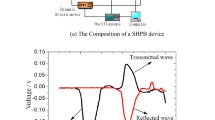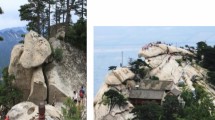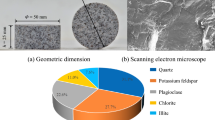Abstract
The freeze-thaw damage of granite was studied used SHPB tests and numerical simulation in the paper. All the granite samples were taken from high altitude localities in Tibet, China, which were made impact loading test after freeze-thaw cycles. The strain rate was unified in the use of SHPB tests combined with numerical simulation to analyze the relationship between dynamic strength and freeze-thaw cycles. The results shows, under different freeze-thaw cycles, the shapes of the reflected and transmitted waves before and after freeze-thaw are different, mainly reflected in the great difference of the curves before and after the peak. With the increase of the freeze-thaw cycles, the peak value of the strength curves decrease apparently and the peak stress decreases apparently after 10 cycles. Samples have different strain rates with the same incident wave under different freeze-thaw cycles. The dynamic strength of granite is associated with the strain rate and the freeze-thaw cycles. Study on the freeze-thaw damage of granite under impact loading is the basis of the granite dynamic constitutive relation and it is important to analyze the stability of open-pit mine slope in seasonal frozen regions.









Similar content being viewed by others
References
Altindag R, Alyildiz IS, Onargan T (2004) Mechanical property degradation of ignimbrite subjected to recurrent freeze-thaw cycles. Int J Rock Mech Min Sci 41:1023–1028
Amin J, Nikudel MR, Khamehchiyan M (2013) Predicting the long-term durability of building stones against freeze-thaw using a decay function model. Cold Reg Sci Technol 92:29–36. https://doi.org/10.1016/j.coldregions.2013.03.007
Anderson CE Jr, O’donoghue PE (1992) Numerical simulations of SHPB experiments for the dynamic compressive strength and failure of ceramics. Int J Fracture 55:193–208
Bailly P, Delvare F, Vial J, Hanus JL, Biessy M, Picart D (2011) Dynamic behavior of an aggregate material at simultaneous high pressure and strain rate: SHPB triaxial tests. Int J Impact Eng 38:73–84. https://doi.org/10.1016/j.ijimpeng.2010.10.005
Bell FG (2000) Engineering properties of soils and rocks, 4th edn. Blackwell Science, Hoboken
Celik MY (2017) Water absorption and P-wave velocity changes during freeze-thaw weathering process of crosscut travertine rocks. Environ Earth Sci 76(12):409
Christopher SM (2011) Development of geomaterial parameters for numerical simulations using the Holmquist–Johnson–Cook constitutive model for concrete. ARL-TR-5556, U.S. Army Research Laboratory, Orlando
Cusatis G (2011) Strain-rate effects on concrete behavior. Int J Impact Eng 38:162–170
Dong G (2005) The mumerical simulation of split Hopkinson pressure bar experimental technique. HeFei University of Technology, Hefei
Ghobadi MH, Beydokhti ART, Nikudel MR (2016) The effect of freeze-thaw process on the physical and mechanical properties of tuff. Environ Earth Sci 75(9):846. https://doi.org/10.1007/s12665-016-5664-8
Graham J, Au VCS (1985) Effects of freeze-thaw and softening on natural clay at low stresses. Can Geotech J 22:69–78
Hashemi M, Goudarzi MB, Jamshidi A (2018) Experimental investigation on the performance of Schmidt hammer test in durability assessment of carbonate building stones against freeze-thaw weathering. Environ Earth Sci 77:684
Holmquist TJ, Johnson GR, Cook WH (1993) “A computational constitutive model for concrete subjective to large strains, high strain rates and high pressures”. presented at International Symposium on Ballistics 14, pp 591-600
Huang S, Liu Q, Cheng A, Liu Y (2018) A statistical damage constitutive model under freeze-thaw and loading for rock and its engineering application. Cold Reg Sci Technol 145:142–150. https://doi.org/10.1016/j.coldregions.2017.10.015
Ince I, Fener M (2016) A prediction model for uniaxial compressive strength of deteriorated pyroclastic rocks due to freeze-thaw cycle. J Afr Earth Sci 120:134–140. https://doi.org/10.1016/j.jafrearsci.2016.05.001
Khoogar AR, Mohades MA, Vahedi Kh (2013) A novel study of penetration into concrete targets by ogive nose projectiles. Int J Adv Des Manuf Technol 6(3):1–7
Khuda S, Albermani F, Veidt M (2017) Flexural strength of weathered granites: Influence of freeze and thaw cycles. Constr Build Mater 156:891–901. https://doi.org/10.1016/j.conbuildmat.2017.09.049
Lajtai EZ, Scott Duncan EJ, Carter BJ (1991) The effect of strain rate on rock strength. Rock Mech Rock Eng 24(2):99–109
Li X (2014) Rock dynamics fundamentals and applications. Science Press, Beijing
Li X, Chen S, Gu D (1994) Dynamic strength of rock under impulse loads with different stress waveforms and durations. J Cent-South Inst Min Metall 25(3):30
Li XB, Lok TS, Zhao J (2005) Dynamic characteristics of granite subjected to intermediate loading rate. Rock Mech Rock Eng 38(1):21–39
Li JL, Zhou KP, Liu WJ, Deng HW (2016) NMR research on deterioration characteristics of microscopic structure of sandstones in freeze-thaw cycles. Trans Nonferrous Met Soc China 26(11):2997–3003. https://doi.org/10.1016/S1003-6326(16)64430-8
Liping W, Ning L, Jilin Q, Yanzhe T, Shuanhai X (2019) A study on the physical index change and triaxial compression test of intact hard rock subjected to freeze-thaw cycles. Cold Reg Sci Technol 160:39–47
Liu F, Chen G, Li L, Guo Y (2012) Study of impact performance of rubber reinforced concrete. Constr Build Mater 36:604–616
Liu H, Yang G, Ye W (2016) Analysis of water and ice content and damage characteristics of the frozen rock during freezing based on the three-valued segmentation of CT images. J Min Saf Eng 33(6):1130–1137
Mutluturk M, Altidag R, Turk G (2004) “A decay function model for the integrity loss of rock when subjected to recurrent cycles of freezing-thawing and heating-cooling”. Int J Rock Mech Min Sci 41:237–244
Polanco-Loria M, Hopperstad OS, Borvik T, Berstad T (2008) Numerical predictions of ballistic limits for concrete slabs using a modified version of the HJC concrete model. Int J Impact Eng 35:290–303. https://doi.org/10.1016/j.ijimpeng.2007.03.001
Saad A, Guedon S, Martineau F (2010) Microstructural weathering of sedimentary rocks by freeze-thaw cycles: experimental study of state and transfer parameters. Comptes Rendus Geosci 342:197–203. https://doi.org/10.1016/j.crte.2009.12.009
SL264-2001 (2001) Specifications for rock tests in water conservancy and hydroelectric engineering. Yangtze River Scientific Research Institute, Wuhan
Sondergld CH, Rai CS (2007) Velocity and resistivity changes during freeze-thaw cycles in Berea sandstone. Geophysics 72(2):99–105. https://doi.org/10.1190/1.2435198
Walbert C, Eslami J, Beaucour AL (2015) Evolution of the mechanical behaviour of limestone subjected to freeze-thaw cycles. Environ Earth Sci 74(7):6339–6351. https://doi.org/10.1007/s12665-015-4658-2
Wen L, Li X, Wu Q (2016) Study on parameters of Holmquist–Johnson–Cook model for granite porphyry. Chin J Comput Mech 33(5):725–731
Wu X, Li Y, Li H (2011) Research on the material constants of the HJC dynamic constitutive model for concrete. Chin J Appl Mech 25(1):15–22
Xu G (2006) Study on mechanical charateristics of rock at low temperature, damage due to freezing and thawing and mutiphysical coupling problems of rock in cold regions. Grade University of the Chinese Academy of Sciences, Beijing
Yavuz H, Altindag R, Sarac S, Ugur I, Sengun N (2006) Estimating the index properties of deteriorated carbonate rocks due to freeze-thaw and thermal shock weathering. Int J Rock Mech Min Sci 43:767–775. https://doi.org/10.1016/j.ijrmms.2005.12.004
Yu M, Zha X, Ye J (2010) The influence of joints and composite floor slabs on effective tying of steel structures in preventing progressive collapse. J Constr Steel Res 66(3):442–451. https://doi.org/10.1016/j.jcsr.2009.10.008
Acknowledgements
We are grateful to the Fund of Natural science foundation of Hebei Province (E2018210066) and China Postdoctoral Science Foundation (2018M631758) for the continuing support of our work. The authors are deeply grateful for this financial support.
Author information
Authors and Affiliations
Corresponding author
Additional information
Publisher's Note
Springer Nature remains neutral with regard to jurisdictional claims in published maps and institutional affiliations.
Rights and permissions
About this article
Cite this article
Huang, Y., Liang, X., Wen, L. et al. Study on the Freeze-Thaw Damage of Granite Under Impact Loading. Geotech Geol Eng 38, 1053–1063 (2020). https://doi.org/10.1007/s10706-019-01072-z
Received:
Accepted:
Published:
Issue Date:
DOI: https://doi.org/10.1007/s10706-019-01072-z




